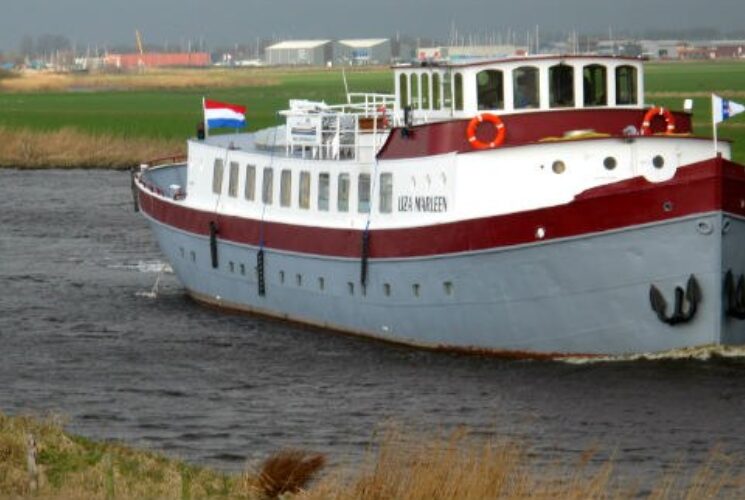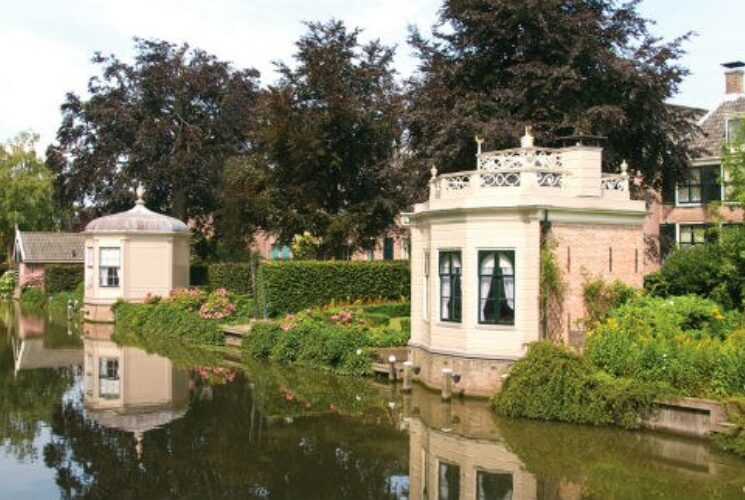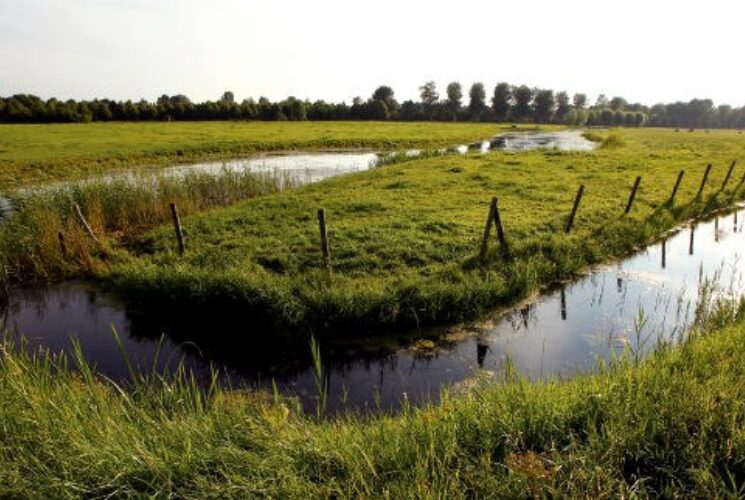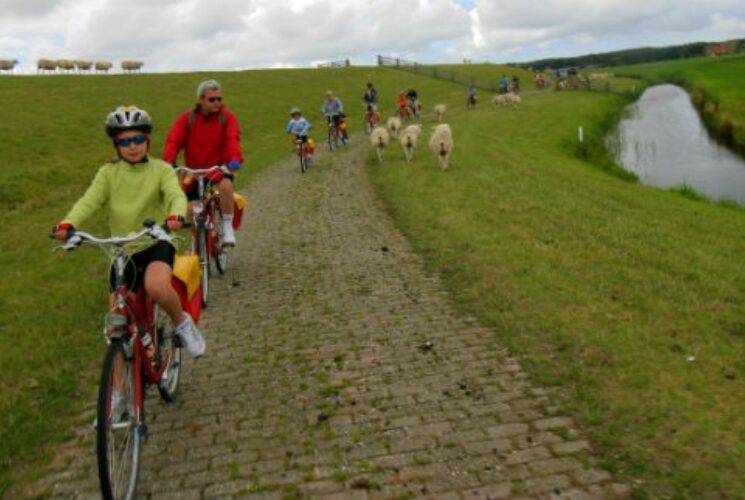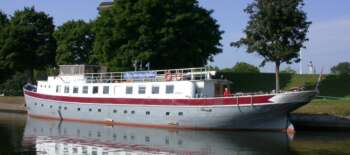Bike and Barge Top of Amsterdam
This boat and bike tour brings you over small dykes and country roads of Northern Holland.
Not until the 17th Century large parts of the area north of Amsterdam were recovered from the sea and reclaimed through the use of hundreds of windmills. It’s here that you will find the typical Dutch landscape of polders, mills and harbours. Many of the windmills are still in working order. You can get a feel for the old Dutch atmosphere in Enkhuizen, Hoorn, Edam and Volendam: traditional costumes, sailing ships and long johns on the clotheslines. If you want to experience what it was to live in one of those villages in the old days we recommend to visit 'het Zuiderzeemuseum'.
On day 4 you’ll sail to Texel, an island with thousands of sheep and a magnificent nature reserve. Back on the mainland the route brings you to Holland’s most beautiful dune area. These are also the only kilometers you will be cycling above sea level!
Alkmaar will also provide a good picture of ancient times. It is the capital of Dutch cheese with its own cheese market and weigh-house for cheese. In Zaanse Schans, a lovely little hamlet on the banks of the river Zaan, the mills, houses, shops and traditional Dutch crafts bring the past to life.
Highlights include:
- Typical fishing villages as Volendam and Enkhuizen
- Isle of Texel
- Alkmaar, the capitel of cheese
- The land of Leeghwater, the Purmer and the Beemster
The route from day to day
- Sat: Amsterdam, embarkation at 4 PM near Central Station, short round trip 15
- Sun: Amsterdam – Volendam, 46, sailing to Hoorn
- Mon: Hoorn - Enkhuizen 34 km Visit the Zuiderzee Museum
- Tue: Enkhuizen - Medemblik and sailing to Texel, 35 km
- Wed:Texel, round trip 35/48/62km
- Thu: Texel, sailing to Den Helder, Den Helder – Alkmaar 58 km
- Fri; Alkmaar – Zaanse Schans – Amsterdam, 55 km
- Sat: Amsterdam, debarkation before 10 AM near Central Station
1 km = 0.62 miles
Day to day schedule
Day 1 Saturday: Amsterdam, embarkation at 4 PM, round tour from the boat, 15 km
A simple settlement at the mouth of the river Amstel, with open connection to the sea: this was Amsterdam in the 12th century. In those days fishermen and craftsmen built a dam in the Amstel (now the site of the National Monument) and Amstel-re-damme was born. Amsterdam was granted its municipal charter somewhere around 1300-1306 and has since expanded continually. In the 17th and 18th century Amsterdammers were the most prosperous Europeans. The famous rings of canals were dug in the Golden Age, the 17th century. Powerful merchants had their abundantly decorated mansions built here, thus manifesting their riches.
Amsterdam is a city to be explored on foot and we recommend the following places of interest: the rings of canals, the Jordaan area, with its many pubs, outdoor cafés and quaint shops, Vondelpark with its open air concerts, Leidseplein, Rembrandtsplein, the antique shops in the Spiegel district, Museum Square with the Rijksmuseum (National Museum), Stedelijk Museum (Museum of Modern Art) and the Van Gogh Museum.
Other typical features of Amsterdam are its numerous 'hofjes' (almshouses), the floating flower market, and the hundreds of houseboats lining the canals.
Amsterdam is inextricably related to the diamond-cutting industry, which has brought much fame to the city since the 17th century.
The palace on Dam Square is sometimes called the eighth Wonder of the World as it was built on 13,650 piles.
Day 2 Sunday: Amsterdam-Volendam, 46 km, sailing to Hoorn
You now leave Amsterdam, which is still very quiet at this hour. A ferry takes you to the Amsterdam Noord quarter and soon you will be cycling through the rural area of Waterland. In this soggy peat land the houses and villages are hardly above the level of the water.
The former isle of Marken is visited. It was not until 1957 that this island was connected to the mainland by a dike and it has retained its own particular character.
The houses here were built on man-made little mounds, called 'werven', to escape the regular inundations. When there was no more room on these mounds people started building houses on piles, which made them stand 2.5 m. above street level. The Marker Museum shows you how people used to live and work here. The inhabitants are the only ones allowed to use their cars, so Marken can only be visited on foot or on bike.
The route is now continued to the historic village of Monnickendam, which received its municipal charter in 1355. There was a flourishing seafaring trade with the Baltic countries (Scandinavia, Estonia, Latvia and Lithuania) and Suriname, as there used to be an direct waterway between the Zuiderzee (the Southern Sea) and the North Sea. When this waterway was closed down, in the 15th century, the importance of Monnickendam declined. However, in the 17th century a barge-canal was dug between Monnickendam and Amsterdam and trading between these cities grew. For a long time past Monnickendam has been renown for its eal smoking. Up to this day eal and other fish is smoked in the harbours.
Now you continue your way along the Gouwzee dike to Volendam, today's destination. Originally Volendam was a small fishing community. Practically all its inhabitants used to wear their distinctive and picturesque traditional costumes. Volendam started as a settlement when Edam (to be visited tomorrow) dug its new, shorter waterway to the Zuiderzee in the 14th century. The old harbour became superfluous, a new dike was built and soon farmers and fishermen settled down. In the second half of the 15th century a new village came into being: Volendam.
From Volendam you sail in northerly direction towards the city of Hoorn. During the evening walk you will have the opportunity to get a good impression of this beautiful city with its rich past. The attractive city of Hoorn was given a municipal charter in 1357. In addition to Amsterdam, Edam, Monnickendam, Enkhuizen and Medemblik Hoorn was a major harbour in the 17th century. From here ships sailed for the Dutch East Indies (now Indonesia), America, Scandinavia and the Mediterranean. The most impressive gable is the one on the former town hall, Statenpoort, which now houses an interesting museum with paintings and exhibits concerning the V.O.C. (United East Indian Company). The V.O.C. was a very powerful, almost monopolistic trading company in the 17th century.
Day 3 Monday: Hoorn – Enkhuizen 34 km, visit Zuiderzeemuseum
You continue on the dike with a wonderful view over the Markermeer on your right and West-Frisian villages on your left-hand side. The recently built dike from Enkhuizen to Lelystad (in the Noordoostpolder) appears on the horizon. This was meant to be a polder dike for a huge new polder: the Markerwaard. However, the plans were never executed: with time perception changed. The environment and fresh water supply became more important. So today the dike is there, but no polder...
The trip for today ends in Enkhuizen, a town which came into existence when two adjoining villages amalgamated. It was given a municipal charter in 1355. In the Golden Age Enkhuizen had grown so much that its harbour was well-known internationally and the beautiful gables, town hall and richly decorated churches all date from these flourishing times. Here too, you can easily find many Renaissance and Baroque monuments. At the end of the 17th century the decline set in, as a result of the wars with England and the growing importance of Amsterdam as a sea trading city. When the Zuiderzee was closed off in 1932 (by the Afsluitdijk) the herring fishing industry also came to an end. The construction of a railway line to Amsterdam, at the end of the 19th century, caused a slight revival for this little town.
In Enkuizen you can visit the Zuiderzeemuseum. This museum, which consists of an indoor and outdoor part, shows you the history of everyday life around the Zuiderzee until the middle of the 20th century. Among other things expositions can be visited here on the reclamation of the Zuiderzee, whale fishing and the rich history of the United East Indian Company. In the open air museum most emphasis is placed on the period between 1880 and 1932. The distinctive smell of fresh tar, smoked fish and peat-heated stoves is all present in the alleys between the 130 buildings.
Day 4 Tuesday: Enkhuizen – Medemblik, 34 km sailing to Texel
The cycling tour starts on the IJsselmeer dike and is then left behind to go through a nature reserve and some typical West-Frisian villages. Then Medemblik comes in sight, the oldest city of West-Friesland (1289), with an illustrious past and with Radboud castle, dating from the 13th century. Once a booming seaport it is now, since the construction of the North Holland Canal, only important as a yacht basin. The flour mill in this town is still in operation. At Medemblik you get on board and sail to the isle of Texel.
You sail across the Ijsselmeer and cross the Afsluitdijk (Enclosure Dam). This dike, connecting North-Holland with Friesland, is about 30 kilometres in length and was the first large civil engineering enterprise against the sea. The dike was completed in 1932 and the Zuiderzee (Southern Sea) changed into the IJsselmeer (IJssel Lake), the largest fresh water lake in the Netherlands.
Day 5 Wednesday: Texel, round trip 35/48/62 km
The isle of Texel, which is one municipality, is the largest of the Dutch Waddeneilanden (Wadden islands). The average length of Texel is 20 km and the average width 8 km.
The first inhabitants of Texel may date from the Middle Stone Age (8,000-4,500 BC). In 1415 the island was granted a municipal charter, which made it the largest official city of the country, in the matter of surface.
Texel is highly appreciated by bird-watchers. In springtime about 80 different types of birds breed her, mainly in the dune areas, but all in all about 300 different species have been perceived on Texel.
As early as in the 16th and 17th century the Texel sheep's cheese was well-known abroad. This was not only the usual white cheese but in particular a special, green cheese. The cheese was green as a result of the juice of boiled sheep droppings, which was stirred through the milk. However, because of hygienic reasons this was forbidden by the Dutch Food Inspection Department in 1930.
Day 6 Thursday: Texel sailing to Den Helder– Alkmaar 58 km
The ship takes you back to the mainland, where you disembark in the city of Den Helder, the Dutch naval port, situated at the mouth of the Noord-Hollandskanaal. This canal was built in order to allow ships to safely enter Amsterdam harbour, thus avoiding the shallow parts of the Zuiderzee. Later on the North Sea Canal was built, allowing even the largest sea-going ships to enter Amsterdam. Den Helder was established around 1500 and is a fishing town as well as a naval base. Ships going to the North Sea and the Waddenzee leave from here.
Today's route takes you through the dunes. South of Callantsoog you pass by the unique nature reserve Het Zwanenwater (The Swans' Water), with its lakes and boggy hollows in the dunes. The name is a reminder of the 17th century, when swans were bred here. Today swans are rare, but some 100 other birds have their residence here.
A little further you cycle on the Hondsbossche Zeewering (Hondsbossche Sea Dike), with a spectacular view of the North Sea. This area used to have dunes, but in 1421 they were swept away in what is known as the St Elisabeth's flood, together with the village of Hondsbosse. The 5 km long basalt dike has replaced the dunes and now keeps the sea at bay.
Near Schoorl you enter the area of the Schoorlse Duinen (Schoorl Dunes), stretching out to Bergen where you will find the highest dunes in the country. During the last century many pine trees were planted here so now it is a rather woody region.
Bergen is an artists' village which attracts many painters, writers and architects.
Your destination for today is Alkmaar, also called the City of Cheese. Its weigh house was the first in the country and it is here that the weighing and trading of cheese used to take place. Near the weigh house many outdoor cafés can be found. Like Amsterdam Alkmaar houses a great many 'hofjes' or almshouses: typical 17th century enclosed courtyards with little houses inhabited by single women and usually supported by the church. A little less than 400 heritage sites, canals and the harbour dominate the townscape.
Day 7 Friday: Alkmaar – Zaanse Schans – Amsterdam 55 km
After leaving Alkmaar the stage takes you through the 'droogmakerij' land with the 17th century towns of Schermerhorn, Graft and De Rijp. A 'droogmakerij' is a specific type of polder: a (part of a) lake around which first a dike was built and which was then reclaimed or impoldered. Within the enclosure of the dikes the water level can be regulated, like in other polders. The general term 'polder' is used for any type of land partly or totally surrounded by a dike in which the water level is regulated.
In Schermerhorn three windmills 'in series' (a 'Molendriegang') can be seen. One of the three, a working 17th century mill, is a museum and shows the system whereby a series of stepped mills, each one a little higher, could pump water to a height of four metres from the polder into the canal behind the dike. Graft and De Rijp are two proud, typical 17th century villages that enjoyed great prosperity at the heyday of the fishing and whaling industries. Jan Adriaansz Leeghwater the well-known polder engineer was born in De Rijp.
If you have not spent too much time at the Alkmaar cheese market you may have time to pay a visit to the Zaanse Schans, a unique hamlet where people live and work, with original houses and windmills from the river Zaan area. Traditionally this was a region where foodstuffs such as edible oil, nuts, rice and grain products were imported and processed. The Zaanse Schans mainly came into being in the sixties and seventies of the 20th century. The original sites of these historical premises hampered the development of the area, which is why they were moved here. At the beginning of the 18th century the area boasted more than 600 windmills! Nowadays nearly all of them have been replaced by motor-driven pumps. The hamlet is dominated by three operating windmills, the oldest built in 1673, for grinding mustard, spices, paint and oil and for sawing wood into planks. As you walk through the village you will see a clock museum, an old-fashioned grocery store, a house with period furniture, a clog maker and a cheese farm.
The last stretch of the trip takes you through ’t Twiske (the Twiske) Leisure Park. Since the beginning of the Christian era the peat region around the Zaan had been used for cattle grazing. In the peat land ditches were dug to help draining the land. The dried peat was used as fuel. Small and larger meadows were thus created over the centuries, which made it almost impossible to keep cattle. In 1938 it was therefore decided to impolder the Twiske region. Many unemployed people from the surroundings were deployed to this task. In 1956 all activity was brought to an end. The southern part of the area had been drained and the little river called Twiske had all but disappeared. A few years later a lot of sand from underneath the peat and clay layers was used for the construction of a motorway leading into Amsterdam. An artificial lake was the result. This was very convenient as there was a growing demand for recreational areas near the big cities. The water surface was enlarged to 200 hectares, the river Twiske was dug out again, and the Twiske area was laid out for various sorts of leisure. Once you are back at the boat in Amsterdam it is time to take leave of your bikes. In the afternoon there is still some time to go into town and after dinner you may want to finish off your trip by going on a city walk or taking a trip on one of Amsterdam's canal boats.
Day 8 Saturday, Amsterdam, end of tour after breakfast.
Included
- All nights on board (incl. bedding, towels, soap)
- Breakfast and dinner on board
- Lunch packages when on the road
- Coffee and tea on board
- Tour guide, cycles with the group
- Min. 3 city walks with tour guide
- Free WiFi (limited available in lounge and on deck)
- Road book, 1x per cabin
- Ferry fares on the route
- GPS-tracks (on request)
Not included
- Bicycle rent (see below)
- Entrance fees to museums; approx. € 25,- per tour
- Personal insurance
2025
- Rental bike per week, bike insurance included € 115,-
- E-bike per week, bike insurance included € 225,-
- Special diet (gluten free; lactose free; vegan) € 100,- per diet
Dutch Barge Cruises reserves the right to cancel tours with fewer than 12 participants up to 21 days prior to the date of departure. The program is subject to change without notice.
Please note that the tour prices are based on the current fuel price.Should the fuel price increase more than 5% (reference date May 2025), then we need to ask a supplement. Even for reservations already made.
| Cabins 2025 p.p. EUR | |
|---|---|
| Twin cabin | € 1.480 |
| Superior cabin (15 m²) for 2 pax | € 1.710,- |
| Superior cabin (15 m²) for 3 pax | € 1.350,- |
| Single use | € 2.220 |
| Bicycle rent | € 115,- |
| E-bike | € 225,- |


